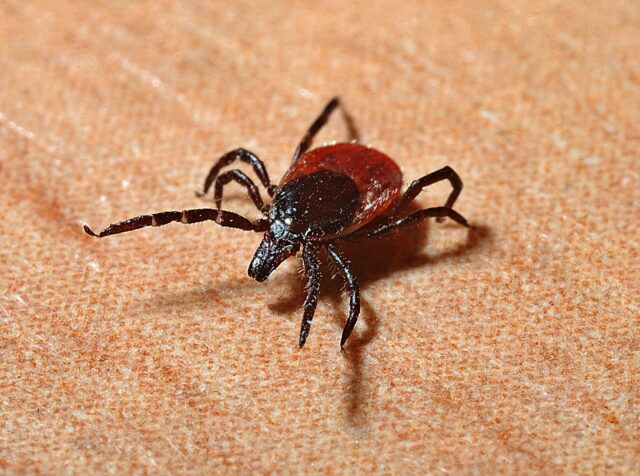Lyme disease is a tick-transmitted ailment that’s common in dogs. Luckily, monthly preventatives help keep them safe from concerns like this, but nothing is 100% effective. So, with Lyme disease seemingly on the rise, it’s a good time to make sure your dog is as protected as possible.
Vets in Maine have been seeing Lyme disease cases at least once a day, which is more than in previous summers. They believe there are a few factors contributing to these rising numbers, and they’re recommending many precautions pet parents should take to keep ticks away from their furry friends.

An Increasing Risk of Lyme Disease
Dr. Julia Lucas from Cumberland Animal Clinic in Maine said that she’s extra busy because of an increase in Lyme disease cases. She said one of the first signs is when pets seem tired or lethargic. Then, symptoms can quickly worsen if not detected.
“We are seeing at least a positive every day, sometimes two or three positives a day on our blood work,” Lucas said.
Dr. Lucas believes the increase this year has to do with the rising temperatures causing ticks to become active earlier in the year. She also pointed out that a lot of people adopted pets for the first time during the pandemic, so they might not know how to properly protect their pets from fleas and ticks.
RELATED: Ehrlichiosis- The Other Tick-Borne Disease You Need To Know About

Ticks need to be attached to a dog for at least 24 hours to spread the bacteria that cause Lyme disease. Lyme disease symptoms could be minor for months but eventually become life-threatening if not noticed in time. Deer ticks (also known as black-legged ticks) are the most common carriers of Lyme disease bacteria.
According to Dr. Lucas, cats aren’t at risk of Lyme disease like dogs are because they’re more resistant to the bacteria.
Common Symptoms of Canine Lyme Disease
If you recently had to pull a tick off your dog, you should keep an eye out for Lyme disease symptoms. Ticks that are spotted right away won’t have enough time to pass the bacteria to your dog, but it’s easy for these tiny critters to go unnoticed in your dog’s fur.
Here are some symptoms of Lyme disease in dogs:
- Lethargy
- Lameness
- Joint swelling
- Stiffness
- Fever
- Loss of appetite

In severe cases, Lyme disease can cause kidney damage in dogs. It could also harm the heart and nervous system.
If you notice one or more of the above symptoms, even if you haven’t found a tick on your dog, you should schedule a vet check-up. It’s better to be safe than sorry with your pup’s health.
Can Lyme Disease Be Treated?
Yes, canine Lyme disease can be treated by giving the dog antibiotics for about 30 days. Depending on the situation, prolonged symptoms may occur, requiring further treatment.
Luckily, Lyme disease isn’t contagious and can’t be passed from a dog to other pets or humans. However, if you were in the same environment as your dog, make sure you check for ticks on yourself.
Ways to Prevent Canine Lyme Disease
Prevention is the key to keeping ticks away, and it can help you worry less about your dog getting sick. Anywhere with long grass could carry ticks, even backyards and parks. So, you don’t have to be camping or hiking in a secluded area for your dog to be at risk.

Conduct Regular Tick Checks
Checking your dog for ticks is the best way to keep them safe. Feel around their body for small lumps that could be ticks, especially right after they walked through tall grass. If you see a tick climbing on them or biting them, remove it immediately. Using tweezers is the easiest way to safely remove a tick.
Ticks like to bite soft parts of the body or hidden areas. So, pay close attention around their toes, ears, lips, and butt.
Use a Monthly Preventative
No matter where you live, your dog should be taking some type of flea and tick preventative. Most options need to be given every 30 days to be most effective, and you can buy topical options at pet stores.
Oral preventatives are more effective than topical ones, but they require a vet’s prescription. If you live somewhere that’s warm year-round, they’ll be the safest option for your pup.
RELATED: 5 Things You Need To Know About Your Flea/Tick Preventative

Take Your Veterinarian’s Advice
If you want more tips on how to protect your dog from Lyme disease, talk to your vet about precautions to take. There is a Lyme vaccine for canines, but it might not be beneficial for every dog, so ask your vet if it’s right for your furry friend.
It’s important to keep an eye out for ticks every year, but with Lyme disease on the rise, it’s extra crucial now. So, if you haven’t checked your dog for ticks recently, do that as soon as possible. Even if they’re on a preventative, they could still be affected.
 Toledo, United States.
Toledo, United States.
